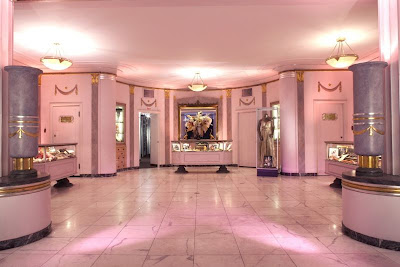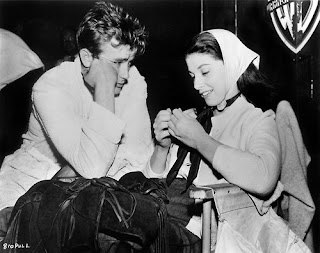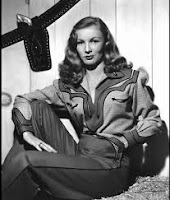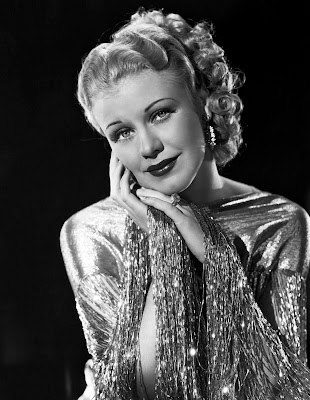The front lobby of The Hollywood Museum.
After living in Los Angeles for six and a half years, I finally made it to one of the tourist cornerstones of Hollywood and Highland: The Hollywood Museum. You'd think it would be a no-brainer for me to visit this den of cinematic archaeology sooner, but in a way I am glad that I waited. Finding and exploring a new jewel is nice, especially after scouring the whole city and thinking that I'd left no stone unturned. Then again, perhaps the "cheesy" factor delayed my interest. Beings that the museum is located next to a Ripley's Believe It Or Not, I often opted for "not," thinking it was a mere magnet for out-of-towners and that there would be little to engage a true connoisseur's interest (ahem). Well, thank God I finally got bored on a Sunday, because to the museum I did go, and I left more than pleased.
One of the pairs of ruby slippers worn by Judy Garland
during The Wizard of Oz.
Sandwiched between Ripley's and Mel's Diner, The Hollywood Museum is situated in the old Max Factor building at 1660 N. Highland Blvd. Due to its locale at the old make-up haven, the first floor is almost entirely dedicated to cosmetics and beauty. Different rooms, labeled by hair-color, feature different actresses, and artifacts like Joan Crawford's old make-up case are on display. The "Brownettes Only" room dedicates much of its space to Judy Garland: one of Frances Gumm's original, tiny stage outfits and Dorothy's Ruby slippers are proudly encased for drooling gawkers. The "Brunettes Only" room equally pays particular attention to Elizabeth Taylor, as the "Red Heads Only" does to Lucille Ball.
The dress Marilyn Monroe wore while entertaining the
troops in Korea (Sorry for the glare).
The museum too, unbeknown to me, possesses one of the most extensive collections of Marilyn Monroe treasures, which are of course shown in the "Blondes Only" room. Her old makeup, famous dresses she wore, and a memorial case dedicated to her untimely death are visible, as is a strange gadget that seems to be an early attempt at the "face-lift." It bears a stronger resemblance to the iron maiden, but for your mug. Needless to say, (or should I say "needles?"), I was scared. Apart from the make-up rooms, the back corridors lead you to a garage where Marilyn's private limousine is parked. I wanted to get a closer look, but was afraid that the monkeys from the Planet of the Apes display would come after me.
The early face-lift: The Max Factor Beauty Calibration Machine,
still raising eyebrows...
Also on the first floor is an extensive anthology of signatures collected by notorious autograph hound Joe Ackerman. This guy got everybody's John Hancock, and now the majority of them hang on the walls, encased in picture frames according to various movies. The cast of Gilda adorns one wall, Tarzan another, but most happily to me the cast of The Great Dictator was hanging for all to see, complete with the signatures of Paulette Goddard and the Charlie Chaplin. Down another walkway is a room featuring a miniature representation of the barn used as Cecil B. DeMille's first office, used when filming The Squaw Man. This is now known as the Hollywood Heritage Museum, another superb spot. Glamour shots of all of cinema's greatest stars-- Spencer Tracy, Bette Davis, Lon Chaney, etc-- also decorated the walls, along with some beautiful photos of Hollywood's growth from the early, nearly vacant silent years to the bustling times of Schwab's Diner. The temptation to slip one of these portraits under my arm was hard to fend off.
Ackerman autographs from The Great Dictator: Charlie, Paulette,
Jack Oakie, and Billy Gilbert.
From here I went downstairs to the "Hall of Horrors," which apparently was once a speakeasy, and where now a great many props from classic horror films are on display. I spied the mask of Jason Voorhees, the dresses of Elvira and Vampira, and most impressively the facial casts of some of Horror's greatest stars: Lon Chaney, Jr, Boris Karloff, Bela Lugosi, Peter Lorre, Vincent Price, and Christopher Lee (left). There was more than scary-stuff downstairs, however, and I was pleased with a display showcasing wardrobe from both the 1917 and 1934 versions of Cleopatra. Theda Bara's headdress and Claudette Colbert's gown were both featured. The big finale was the long, dark walk down Hannibal Lane, where a complete re-creation of Lecter's cell stood waiting at the very end. I admit that I got chills when nearing it. As in the film, a folded chair awaited Clarice Starling, and Hopkins's inmate costume and infamous mask within the cell completed the illusion.
Can you smell the fava beans? (Sorry for the darkness).
The upper floors are dedicated to rotating displays, which is what makes the museum worthy of multiple visits. When I was there early this September, I lucked out in being able to witness the "Lucille Ball at 100, I Love Lucy at 60" display. In addition to several of the awards that the lovable Lucy won over the years, various props, costumes, and personal dresses she wore to awards shows were present. One of my favorite features was the famous "three-headed monster," which was an innovative piece of equipment used to film what is now considered the first official sitcom. Much attention was equally paid to Desi Arnaz, Vivian Vance, and William Frawley. As a Gustav Klimt fan, I was also appreciative of the "Portrait of Emilie Floge" re-creation with Lucy standing in for Emilie (right).
I Love Lucy's "Three-headed Monster."
And finally, the "piece de resistance" was the top level, devoted to one of my all time favorites, Jean Harlow. Another hundred year tribute, this exhibit proved that the sweet and gorgeous Jean continues to shine so many years after her death. Much like the Lucy display, there were several dresses to view, as well as enlarged photos of the glamour vixen (in youthful days, left), and personal letters and documents on display. Seeing first-hand the correspondence and penmanship of this silver screen goddess was quite moving, especially when perusing cute notes to friends and colleagues. As big as she became, Jean clearly always remained down to earth and loyal to her pals. Another object worth mentioning was the movie star mural that husband Paul Bern apparently commissioned for their short-lived home together on Benedict Canyon. It depicts a fictional, ancient banquet scene with Jean at center table and other actresses like Joan Crawford and Norma Shearer in attendance. It was quite decadent and unexpected. By far, the most impressive was her personal Packard on display. I don't know much about automobiles, but in this case it was love at first sight. Jean definitely had taste.
Jean's 1932 Phaeton Packard. Yum.
In the back on this same floor, more space was dedicated to other historical mementos, including a roulette table from the infamous Pickfair, gowns worn by Mae West, Greta Garbo, and Clara Bow, and Pee Wee Herman's bicycle. I wish I had had more time to really peruse everything with great scrutiny, but I literally would have had to spend hours there to do so. All in all, it was a great experience with some truly jaw-dropping exhibits and unexpected charms. The downside was that in appearance the museum was a bit cluttered, but I could hardly blame them with all of the artifacts they have to jam into one place. It's still worth a visit to those truly interested in Hollywood history and the preservation of its favorite players. I will definitely be going back when a new display comes to town.
The much beloved Roddy MacDowell's powder room, complete
with friends' pictures and autographs.
To visit the The Hollywood Museum:
1660 N. Highland Avenue
Hollywood, CA 90028
323-464-7776
$15 for Adults
Open 10am-5pm Wed-Sun.

































